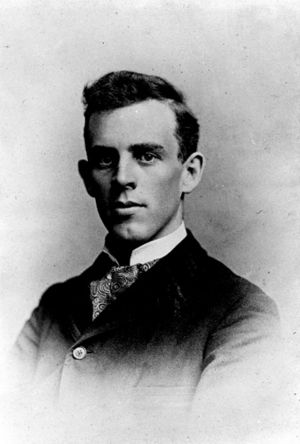David Fairchild facts for kids
Quick facts for kids
David G. Fairchild
|
|
|---|---|

David Fairchild in 1889
|
|
| Born | April 7, 1869 |
| Died | August 6, 1954 (aged 85) |
| Nationality | American |
| Alma mater | Kansas State College of Agriculture |
| Known for | Incorporating non-native food and other commercial plants into American agriculture |
| Spouse(s) | Marian Hubbard Bell |
| Awards | Public Welfare Medal (1933) |
| Scientific career | |
| Fields | Botany |
| Institutions | US Department of Agriculture |
David Grandison Fairchild (born April 7, 1869 – died August 6, 1954) was an American botanist and plant explorer. He traveled the world to find new plants. Fairchild helped bring over 200,000 different kinds of plants to the United States. These included important foods like soybeans, pistachios, mangos, nectarines, and dates. He also introduced bamboos and beautiful flowering cherries. Some of the plants he brought, like certain types of wheat, cotton, and rice, became very important for the American economy.
Contents
Early Life and Education
David Fairchild was born in Lansing, Michigan. He grew up in Manhattan, Kansas. His father, George Fairchild, was the president of Kansas State College of Agriculture. David studied there too, earning his first degree in 1888 and a master's degree in 1889. He continued his studies at Iowa State and Rutgers. In 1915, he received an honorary science degree from Oberlin College.
Plant Exploring Adventures
David Fairchild became a plant explorer for the U.S. Department of Agriculture. He was encouraged by Barbour Lathrop, a rich traveler. Lathrop and another wealthy supporter, Allison Armour, helped pay for many of Fairchild's trips. Fairchild wrote popular books about his plant collecting journeys. He once said he was glad he saw "a few of the quiet places of the world before the coming of automobiles."
For many years, Fairchild managed the Office of Seed and Plant Introduction for the U.S. Department of Agriculture. One of his famous achievements was helping to bring cherry trees from Japan to Washington, D.C. He also helped introduce foods like kale, quinoa, and avocados to Americans.
In 1898, he started a special garden in Miami, Florida, for new tropical plants. In 1905, he married Marian Hubbard Bell, who was the daughter of Alexander Graham Bell, the inventor of the telephone. Fairchild was also involved with the National Geographic Society.
The Kampong and Legacy
In 1926, the Fairchilds built a home in Coconut Grove, Florida. They called it "The Kampong". This name came from family homes in Java, Indonesia, where Fairchild had collected many plants. He filled his property with amazing and rare tropical trees and plants. He even wrote a book about it called The World Grows Round my Door. Today, The Kampong is part of the National Tropical Botanical Garden.
In 1938, a famous garden in Coral Gables, Florida, was named after him: the Fairchild Tropical Botanic Garden. This was a great honor for his work.
Fairchild was also a member of the board of regents for the University of Miami from 1929 to 1933. In 1933, he received the Public Welfare Medal from the National Academy of Sciences. This award recognized his important contributions to science.
His son, Alexander Graham Bell Fairchild, became a research entomologist (someone who studies insects). His daughter, Nancy Bell, also married an entomologist. She wrote a book about her experiences living in rural Colombia.
David Fairchild's name is also used for a species of lizard, Anolis fairchildi.
Important Plant Introductions
David Fairchild played a big part in bringing new types of plants to the United States. He helped introduce many plants that became important for food and farming.
Pima Cotton
Around 1900, the U.S. was a leader in cotton production. However, the southwestern U.S. didn't grow much cotton. Egypt, at that time, produced a very high-quality cotton. Experts at the U.S. Department of Agriculture believed that Egyptian cotton would grow well in the deserts of the southwestern U.S. if it was irrigated.
In 1902, David Fairchild traveled to Egypt for the USDA. He brought back several types of Egyptian cotton. A team led by Thomas H. Kearney then worked with these plants. After about ten years, they developed a new type of cotton that grew very well in the southwestern U.S. This special, high-quality cotton became known as Pima cotton.
Books by David Fairchild
Fairchild wrote four books about his many travels and his work bringing new plants to the United States. These books not only share his knowledge about tropical plants but also describe the cultures he saw before they changed much. He was a skilled photographer and included his own pictures in his books.
- The World Was My Garden: Travels of a Plant Explorer (1938)
- Garden Islands of the Great East: Collecting Seeds from the Philippines and Netherlands India in the Junk 'Chêng ho (1943)
- The World Grows Round My Door; The Story of The Kampong, a Home on The Edge of the Tropics (1947)
- Exploring for Plants (1930)
His book The World Was My Garden won a special award in 1938 called the Bookseller Discovery. This award was for a deserving book that didn't get enough attention or sales.
Fairchild and his wife Marian also wrote an early book about taking close-up pictures of insects. It was called Book of Monsters (1914). He also wrote many scientific papers about plants, plant exploration, and how to grow new plants in the U.S.
See also
 In Spanish: David Fairchild para niños
In Spanish: David Fairchild para niños

